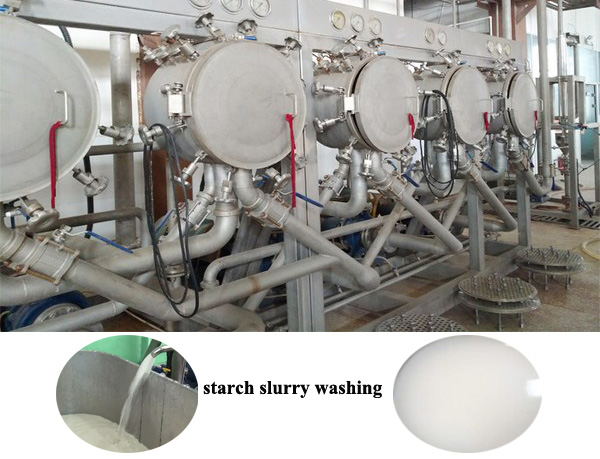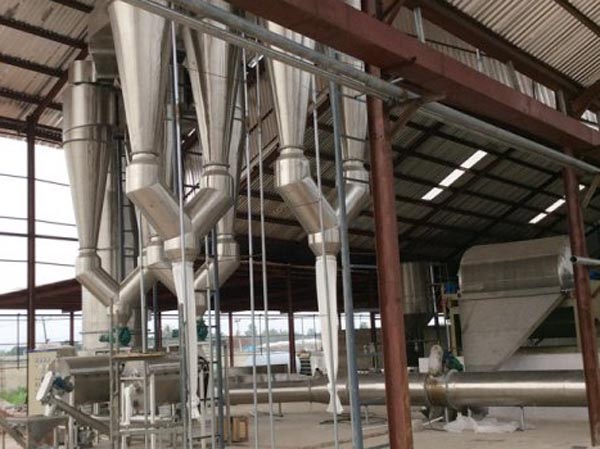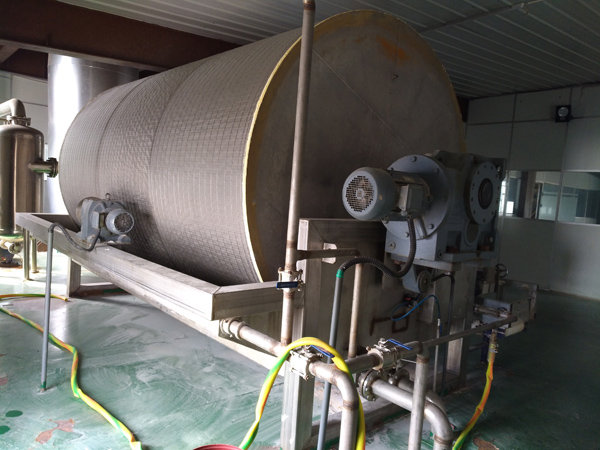industrial starch production from cassava pdf
industrial starch production from cassava pdf-journals on procedure of flour processing machine from cassava-tapioca powder making plant equipment

Cassava starch is produced primarily by the wet milling of fresh cassava roots but in some countries such as Thailand it is produced from dry cassava chips. Starch is the main constituent of cassava. About 25% starch may be obtained from mature, good quality tubers. About 60 % starch may be obtained from dry cassava chips and about 10 % dry pulp may be obtained per 100 kg of cassava roots.
Fresh tubers are processed during season and dry chips during the off-season in some countries. Extraction of starch from fresh cassava roots (Fig. 1) can be divided into five main stages: preparation (peeling and washing), rasping/pulping/grating, purification (starch washing), dewatering and drying, and finishing (milling and packaging).
For cassava, the process of starch extraction is relatively simple as there are only small amounts of secondary substances, such as protein, in the roots. When cassava roots are harvested or selected for starch extraction, age and root quality are critical factors. Cassava roots need to be processed almost immediately after harvest, as the roots are highly perishable and enzymatic processes accelerate deterioration within 1-2 days. A first-rate quality starch can be obtained from cassava using only water, and this makes the processing of cassava starch and flour particularly suitable for developing countries and rural industries.
Advantages of cassava starch
Cassava has many advantages for starch production.
High level of purity.
Excellent thickening characteristics.
A neutral (bland) taste.
Desirable textural characteristics.
A relatively cheap source of raw material containing a high concentration of starch (dry-matter basis) that can equal or surpass the properties offered by other starches (maize, wheat, sweetpotato, and rice).
Cassava starch:
is easy to extract using a simple process (when compared to other starches) that can be carried out on a small-scale with limited capital.
is often preferred in adhesive production as the adhesives are more viscous, work more smoothly, and provide stable glues of neutral pH
has clear paste.
The development of both the food and non food uses of cassava starch has made much progress and continues to have a bright future. Both old and important new products, such as modified starches, starch sugars, starch-based plastics and fuel alcohol, are reviewed briefly.
Native starches
Starch can be classified into two types: native and modified. Native starches are produced through the separation of naturally occurring starch from either grain or root crops, such as cassava, maize, and sweetpotato, and can be used directly in producing certain foods, such as noodles. The raw starches produced still retain the original structure and characteristics and are called “native starches”. Native starch is the basic starch product that is marketed in the dry powder form under different grades for food, and as pharmaceutical, human, and industrial raw material. Native starch has different functional properties depending on the crop source, and specific types of starch are preferred for certain applications. Native starch can be considered a primary resource that can be processed into a range of starch products.
Native starches have limited usage, mainly in the food industry, because they lack certain desired functional properties. The native starch granules hydrate easily when heated in water, they swell and gelatinize; the viscosity increases to a peak value, followed by a rapid decrease, yielding weak-boiled, stringy, and cohesive pastes of poor stability and poor tolerance to acidity, with low resistance to shear pressure, as commonly employed in modern food processing.
However, food, metallurgic, mining, fermentation, construction, cosmetics, pharmaceutical, paper and cardboard, and textiles industries among others use native starch in its traditional form.
Adaptability of the Technology
Thailand imports wheat flour for baked goods and other food products to a value of about US$120 million each year. The use of a locally produced cassava flour to replace wheat flour as a source of carbohydrate would reduce the cost of production and save on foreign exchange ( Fig. 4(954)). The production of cassava flour is a simple technology that farmers can do for themselves. In this way, farmers can increase their incomes.
How to Make the Flour
To produce cassava flour, first wash the fresh roots then peel them. Wash the peeled roots. The roots are then chopped into small pieces about 5 x 0.5 x 0.2 cm, and sun-dried for two or three days (or dried in a hot air oven at 55oC). After drying, the moisture content of the cassava chips should be less than 8%.
The chips are then milled, and the flour sieved through an 80 mesh sieve. Finally, the flour is packaged in plastic bags. Packaged in this way, the flour can be stored for at least eight months. The yield recovery of flour is about 20 - 40%, depending on the cultivar, the time of harvest and the equipment used.
Avoiding Toxicity Problems
Good-quality cassava flour should be white and have a good smell. It should not be contaminated by insects or undesirable microorganisms. If drying takes place outdoors, this should be done on sunny days, otherwise the chips may smell bad and turn brown.
It is best to use cassava cultivars which contain a low level of cyanogenic compounds, since these are potentially toxic. However, the cyanogenic content of fresh roots is not a serious problem in cassava flour production, since it is almost entirely eliminated during flour processing. Furthermore, Thailand's traditional cassava cultivars do not contain a high level of hydrocyanic acid. Our experiments on dried chips of cassava from nine cultivars found that the hydrocyanic content fell from 13.5-114.7 ppm in the fresh roots to 0.40- 2.37 ppm in the flour. The level varied according to the cultivar and the time of harvest.
Cassava Flour As a Substitute for Wheat Flour
Cassava flour does not contain any gluten. If it is used to replace wheat flour 100%, the quality of the product will be different. A suitable ratio for replacing wheat flour that consumers find acceptable depends on the kind of food.
For example, cassava flour can replace 75% of wheat flour in sponge cakes and chiffon cakes, 50% in butter cakes and cookies, 25% in doughnuts and spaghetti, and 20% in bread ( Fig. 5(837) and Fig. 6(900)). Cassava flour can be used to replace 25 - 50% of the rice starch in noodles, and will make the noodles softer and more elastic ( Fig. 7(1114)).
How much does a cassava starch Read More
How much does a cassava starch machine cost - The price of a cassava starch production line machine...
The cassava starch production lRead More
The following are the main steps and equipment components of a typical cassava starch production line:Cleaning and peeling: Clean the harvest...

scale cassava flour processing
This is the second time that a Nigerian customer has purchased cassava processing equipment from SDA Holdings-Kaifeng SDA Agricultural Equipment Engineering Co., Ltd. Nigerian customers have previously purchased a cassava peeling machine. SD
Read More
Cassava starch production plant
Cassava starch production plant installed in Nigeria,One day processing 100 tons of tapioca starch processing machinery and equipment,We provide customers with tapioca starch processing machine turnkey engineering
Read More



 machine366@outlook.com
machine366@outlook.com




